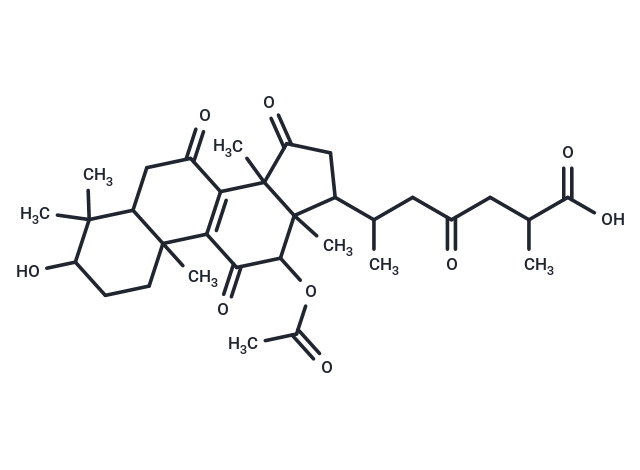Shopping Cart
- Remove All
 Your shopping cart is currently empty
Your shopping cart is currently empty

Ganoderic acid H is a potent antitumour agent, it mediates its biological effects through the inhibition of transcription factors AP-1 and NF-κB, resulting in the suppression of secretion of uPA.

| Pack Size | Price | Availability | Quantity |
|---|---|---|---|
| 1 mg | $247 | In Stock | |
| 5 mg | $697 | Backorder |
| Description | Ganoderic acid H is a potent antitumour agent, it mediates its biological effects through the inhibition of transcription factors AP-1 and NF-kappaB, resulting in the down-regulation of expression of Cdk4. |
| In vitro | In highly invasive human breast cancer cells, Ganoderic acid H suppressed growth (cell proliferation and colony formation) and invasive behavior (adhesion, migration and invasion) of MDA-MB-231 cells[1]. Furthermore, the activity of Ganoderic acid H is linked to the hydroxylation in the positions 7 and 3 in its triterpene lanostane structure[1]. Ganoderic acid H could be a promising natural agent for the therapy of invasive breast cancers[1]. |
| Molecular Weight | 572.69 |
| Formula | C32H44O9 |
| Cas No. | 98665-19-1 |
| Smiles | CC(CC(=O)CC(C)C(O)=O)C1CC(=O)C2(C)C3=C(C(=O)C(OC(C)=O)C12C)C1(C)CCC(O)C(C)(C)C1CC3=O |
| Relative Density. | 1.25g/cm3 |
| Storage | store at low temperature,keep away from direct sunlight | Powder: -20°C for 3 years | In solvent: -80°C for 1 year | Shipping with blue ice. | |||||||||||||||||||||||||||||||||||
| Solubility Information | DMSO: 80 mg/mL (139.69 mM), Sonication is recommended. | |||||||||||||||||||||||||||||||||||
Solution Preparation Table | ||||||||||||||||||||||||||||||||||||
DMSO
| ||||||||||||||||||||||||||||||||||||

Copyright © 2015-2025 TargetMol Chemicals Inc. All Rights Reserved.